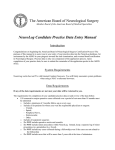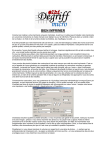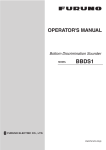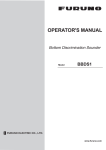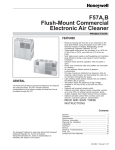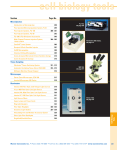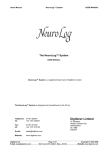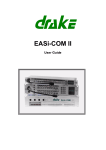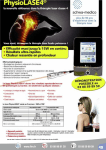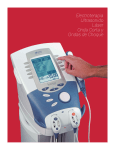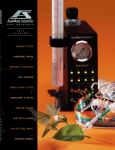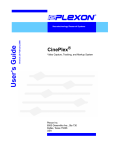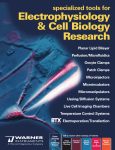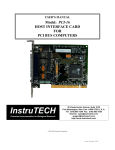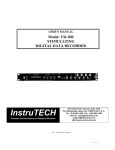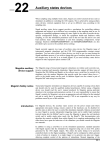Download - Digitimer
Transcript
Digitimes 2002 Bringing you the latest news from Digitimer Acquisition Amplification Antivibration Cell Injection Iontophoresis Noise Elimination Manipulation Micro-Incubation Patch-clamp Perfusion Pipette Manufacture Stimulation Software 1972 - 2002 Thirty Years of Digitimer of our customers. In addition, Digitimer is a representative of at least 8 biomedical research manufacturers, including Heka Elektronik of Germany, Narishige of Japan and Instrutech Corp. of the USA, whose products complement our own established ranges. By coupling an extensive choice of high quality instrumentation with good advice, the staff at Digitimer aim to make your equipment selection process as easy as possible. NeuroLog System - Relieving Laboratory Stress Since 1972! The Welwyn Garden City home of Digitimer T he first "Digitimer" (DIGital Time Interval Marker and Event Release) was designed by HB (Bert) Morton at The National Hospital, London in the early 1960's. This was then manufactured and sold world-wide by Devices Ltd. Other complementary products for medical research followed and Digitimer Ltd became an independent company specialising in electronic instruments for medical research and clinical investigations in 1972. In March of 1997 Digitimer became accredited with the ISO9002 Quality Standard allowing us to produce MDD (Medical Device Directive) compliant products, such as our DS7A constant current high voltage stimulator and the D185 MultiPulse Cortical Stimulator. Digitimer was one of the first companies to recognise the importance of ensuring that our products were CE compliant before the European Directives came into force. We place much effort in modifying, where necessary, our existing products and we continue to place the highest priority on ensuring that all our products meet or exceed the required Standards. At the same time we advise the companies for whom we distribute in the UK, of product modifications required for them to meet EU standards. I n 1972 Digitimer introduced the versatile and modular NeuroLog System, which allowed researchers to carry out intracellular or extracellular amplification, stimulation, pulse generation or signal conditioning, within one compact device. Digitimer prides itself in the close connection we have with universities and hospitals in developing new products. Often these products are used in leading techniques within clinical or research environments. The NeuroLog System was to prove extremely popular as it reduced space & cabling requirements, removed compatibility problems associated with interfacing equipment from different manufacturers and provided a system that could evolve hand in hand with changes in experimental protocols. Our current range of research instruments includes the very popular NeuroLog System, which continues to provide a versatile and cost effective solution to a number of experimental requirements. The system is capable of single- or multi-channel AC/DC amplification, stimulation and signal conditioning tasks. Alongside this, our newer products include the DS3 Isolated Constant Current Stimulator, a descendent of the extremely popular DS2 and latterly the DS2A stimulators and the D360 8-channel patient amplifier. If you know of any potential product that would fit the profile of our range, please make contact with us. Thirty years later, the NeuroLog System remains a firm favourite with many The NeuroLog System researchers worldwide. Today, NeuroLog continues to evolve, with modules being improved, replaced or added to the range, maintaining the functionality and versatility of the system. To find out more, please request a copy of our NeuroLog brochure or visit our website. Digitimer now sells direct to many countries and together with our network of more than 13 companies distributing our products, we hope to provide a knowledgeable, friendly and efficient service to all 1 D330 MultiStim The Multi-Channel Stimulation Solution T Product Focus he D330 MultiStim System is a modular and highly versatile multi-channel stimulator designed to be used by biomedical scientists who wish to accurately stimulate a number of low impedance tissue preparations with different stimulating voltages or currents. The system provides a choice of modules for either constant voltage stimulation (D333H, up to 100V at 1A) or constant current stimulation (D343, up to 500mA from a 100V source). The D335 - Meter can be fitted into the system to allow precise voltage or current monitoring. A selection of timing modules are available to generate pulses, variable in frequency and width, which can be controlled as trains using a gating waveform, variable in repetition rate and duration or pulse count. For ease of use, most modules have an error indicator to warn of incompatible settings or an overload condition. Sockets are fitted to allow full external control and synchronisation if required. The D330 MultiStim System rack/case comes in a 19" rackmountable unit that can house up to ten stimulation channels - along with the Pulse Train Generator and Gating modules. As with many modular systems, some decisions have to be made prior to selection of the right modules. In order to help, we have compiled a number of application diagrams which are downloadable from the Support section of our website (www.digitimer.com/support). As an additional help, the flow chart below illustrates how components of a D330 system should be selected. The D343 constant current dual channel stimulator module D337 Case & Power Supply (14 module bays) Constant Current Constant current or constant voltage stimulation? Use one D343 Dual stimulator for 2 channels of stimulation (0-500mA, 100V max.) Choosing a D330 System Constant Voltage Use one D333H Dual stimulator for 2 channels of stimulation (0-100V, 1A max.) A D330 MultiStim System in use Do you want to reverse stimulus polarity between pulses? NO YES You will need one D342 Dual Bi-Stim for every Dual Stimulator module D344 Remote Interface Module YES External Independent Timing? Single Width Double Width 1 bay per module 2 bays per module D331AT D333H D341A D342 D343 D332T D334B D335 D340 D344 NO D332T Pulse Module D334B Sync Module CONTINUOUS TRAINS Continuous Pulses or Trains? Control of Train by: Duration or Number of Pulses NUMBER OF PULSES TRAIN DUR. Do you need delayed or extra pulses for effective refractory period experiments? If so consider using a D340 Delay module. D331AT Sync + Gate Module D341A Sync + Train Module D335 Meter? The D342 dual bistim module allows stimulus polarity to be alternated Fill remaining empty bays with D330-x Blanks (1,2,5 or 7 wide) 2 Digitimer Clinical Update D185 MultiPulse Cortical Stimulator S urgery to the spine, spinal cord, or blood vessels supplying the spinal cord is accompanied by significant risk to the patient. Of greatest concern is that nerve fibres within the spinal cord with normal function prior to surgery might be damaged as a consequence of the surgical procedures themselves. This damage might occur through a variety of mechanisms, including: 1) direct trauma, as could occur during resection of a tumour from within or lying adjacent to the spinal cord; 2) stretch-induced damage during correction of a spinal curvature (e.g. scoliosis); or 3) loss of blood flow (ischemia) due to occlusion of an arterial supply. Regardless of the mechanism of injury, the reality is that once damaged, individual fibres of the central nervous system rarely recover normal function. The resultant loss of neurologic function of the affected limb(s) or trunk regions can take the form of diminished sensation, increased pain (including abnormal sensations, such as ‘pins and needles’), or loss of muscle strength. Complete functional loss of strength and sensation of areas innervated by the spinal cord at the level of the cervical spine leads to quadriplegia; severe injury at levels caudal to the T1 segment leads to paraplegia. D185 MultiPulse Stimulator One of the quickest ways to detect changes in the conduction properties of the Spinal Cord during Spinal or Cardiac surgery, is to monitor the motor pathways. The Digitimer D185 MultiPulse Stimulator is a unique instrument that combines with existing Evoked Potential (EP) systems to provide the feedback that a number of Neurosurgeons will no longer work without. The D185 was developed from our model D180 stimulator, around 5 years ago, in response to our customer’s requirements for a brief burst of electrical stimuli to elicit reliable Motor Evoked Potentials (MEPs) during Intraoperative Monitoring (IOM). Over this time Digitimer have gathered together numerous papers and abstracts - most of these are available from us using our website “MEP Literature Request” page. DS7A High Voltage Constant Current Stimulator T he DS7A High Voltage Constant Current Stimulator is a very popular product for percutaneous stimulation within clinical or research environments. The stimulator uses mains power to provide a variable compliance of up to 400V, allowing a maximum stimulation current of 100mA or 1A with the DS7AH variant. The stimulator has a built in "single-shot" trigger button, but also accepts TTL trigger input via a BNC socket on the rear of the unit or triggering from a contact closure footswitch. In addition, a TTL output, also on the rear, allows triggering of recording equipment. The DS7A has 6 selectable stimulus durations of betwen 50µs and 2000µs (restricted to 50-200µs with the DS7AH). Electrodes (not supplied) are connected to the stimulator via touch-proof safety sockets. Electrode extension cables are available from Digitimer. DS7A Constant Current Stimulator D360 8-Channel Patient Amplifier T he D360 8 Channel Patient Amplifier System is a computer controlled isolated amplifier. It can be used for multi-channel AC coupled amplification of electro-encephalography (EEG), evoked potential (EP) or electro-myography (EMG) signals. The system comprises a main amplifier unit with a remote active headbox and dedicated Microsoft Windows compatible control software. Multiple D360 amplifiers can be "daisy-chained" to produce a system capable of amplifying a greater number of channels (in multiples of 8). Grouping allows several channels to be configured with the same gain and filter settings, with the result that altering the settings for one of the channels leads to the same change across the group. The control software also provides impedance checking of the electrodes and deblock functions. Analogue output to your chosen acquisition interface is via a "D" connector on the rear of the main unit or from 8 individual BNC sockets on the front panel. The D360 has been designed according to the medical devices directive through implementation of the EN60601 Standard. 3 D360 Patient Amplifier Screenshot of the D360 Amplifier Control Software InstruTECH Precision Instrumentation for Biological Research ITC-1600 - A NEW Optical Acquisition Interface I multielectrode extracellular recordings. ECELL software is compatible with all InstruTECH data acquisition systems and incorporates PCbased data acquisition and analysis into one software package. With ECELL you can acquire, store and display continuous and spiking data from eight analog channels with automatic data decimation for each ECELL Software channel. Each channel can be configured individually to acquire the data using either continuous or event-driven acquisition mode. nstruTECH have introduced the new ITC-1600, a 16 bit multichannel data acquisition system, which replaces the ITC-16. As with it's predecessors, this new interface is a product of I n s t r u T E C H ' s commitment to the manufacture of high quality, low noise instrumentation. The I-1600 rack communicates with the host PC through a fibre I-1600 dual rack & PCI card optic cable and PCI card. Each PCI interface card can control a single or dual I-1600 rack allowing 8 or 16 channel acquisition. If the user requires more channels, further I-1600 racks and PCI cards can be added to a system to upgrade in multiples of 8. InstruTECH have also introduced a low cost turnkey program for acquisition of continuous or spiking data from single or HEKA Launch the EPC 10 Patch Clamp Amplifier S The new flagship of the HEKA range features complete digital control technology, heralded as revolutionary at the time of it's introduction within the EPC9. For many "old-school" patchclampers there still seems to be some mistrust of an amplifier which does not possess manually adjustable dials or switches for setting parameters such as capacitance or series resistance, however, those that have taken a "leap of faith" and used the EPC9 have not looked back. The integrated InstruTECH interface and user programmable/automated controls allow the researcher to acquire data of more complexity, with greater efficiency, reliability and reproducibility than ever before. ince Digitimes 2001, HEKA Elektronik have continued to develop their electrophysiology hardware and software products in order to maintain their leading position in this research field. February saw the launch of the EPC 10 The New EPC 10 Amplifer patch-clamp amplifier. The EPC 10 incorporates the new InstruTECH ITC-1600 interface, and although the amplifier may look very similar to the discontinued EPC9 series, there are some very important changes and enhancements: In parallel with development of the EPC10, HEKA have also placed emphasis on product support, with the initiation of a popular Users Forum which is accessible via their website (www.heka.com). The website also contains FAQ and tips & hints sections as well as a software and user manual download area. - Optical communication with host computer increases the noise performance of the amplifier. - Ultra-slim headstage design provides more space near the preparation. - Low frequency voltage clamp enhances the current clamp recording mode. - True current clamp in fast-mode removes the need to use C-fast compensation. - 16 Digital outputs and inputs on the rear of the unit allow enhanced communication with external devices. EPC7 Last year saw the publication of the first issue of impulse, the latest HEKA newsletter, which will no doubt provide a great source of information to users and prospective users alike. We would be happy to receive suitable methodological or research articles for inclusion in future editions of impulse or Digitimes. P lease contact Gareth Thompson at Digitimer for further information. EPC8 EPC9 EPC10 Four Generations - One Family 4 NEW Perfusion Chambers from AutoMate Scientific Digitimer Exhibition Schedule 2002-3 A utoMate Scientific have recently expanded their range of products to include a recording chamber and petri dish insert which are designed to complement their existing automated perfusion systems. Digitimer regularly exhibit at scientific and clinical conferences around the world. Our full conference schedule can be viewed on our website. If possible, please take the time to visit our stand and discuss your equipment requirements on one of these occasions. The OPC-1 is an extremely low volume (<20µl) Xenopus oocyte perfusion chamber targeted at those carrying out drug applications on oocytes during two electrode voltage clamp recording. The large size of xenopus oocytes has previously made studies requiring rapid solution exchange over the whole oocyte technically demanding. The low volume design of the OPC-1 facilitates such rapid solution exchange. OPC-1 We look forward to meeting you. NEW Narishige Distribution Agreement 35mm Petri dishes offer a perfect recording chamber for many researchers. As a result, AutoMate have designed the PCP-1 petri dish insert which makes bath perfusion in PCP-1 35mm Petri dishes simple to set up and perform. The insert is annular, with an integrated docking port for a teflon manifold and an adjustable waste tube for perfusate removal. The design has been optimised to dampen fluctuations in liquid level as well as reduce the appearance of bubbles in the dish. W e now offer equipment from the complete Narishige range, including their electrophysiology, cellular injection and pipette manufacture products as well as the You Ltd range of manipulators. Digitimer are always looking for equipment which complements our existing range of quality instrumentation. As another well respected manufacturer in the biomedical research field, we saw Narishige as a perfect partner, which would allow us to enhance our limited range of micromanipulation and pipette fabrication products. Complete AutoMate perfusion systems are supplied with a teflon manifold, however, manifolds are available AutoMate perfusion pencils are now available with up to 16 channels separately, making the OPC-1 and PCP-1 compatible with any perfusion system. Over time, Narishige have developed a reputation for high quality manipulation devices and this is still true today. The current range includes fine and coarse, single, two and three axis micromanipulators which feature direct mechanical or hydraulic control. Their pipette fabrication tools such as the PP-830 pipette puller (pictured below) and the MF-830 Microforge are found in laboratories worldwide, where they are employed with great reliability for the production of micropipettes. Anti-vibration Tables and Microscopes from Digitimer? Digitimer can also supply anti-vibration tables, Faraday cages and microscopes from major manufacturers to accompany our own product range. If you are putting together a grant for a new rig, why not ask us to quote you for the lot? Quest Scientific Innovative Devices For Research Still Having problems with 50Hz Noise? = + Genuine biological signal contaminated with 50Hz noise The Hum Bug from Quest Scientific Too good to be true...No, just a 5 The Hum Bug removes the unwanted mains noise A Compact Source of Isolated Stimulation T mounting frame, which is shown with a single DS2A in the photograph. In addition, the mounting frame also accepts our DG2 Trigger Generator, a device which provides a simple method of repetitively triggering the DS2A or DS3. he Digitimer DS2A (constant voltage) and DS3 (constant current) Isolated Stimulators are very popular in many electrophysiology laboratories all over the world. Their compact and user friendly design has generated a loyal following amongst researchers wishing to precisely stimulate nerve or muscle from an isolated power source. Both units can be triggered manually using the front panel singleshot button or automatically in response to TTL compatible trigger pulses from an external source, such as a PC. In addition, pulse duration can be defined by (i) the settings of the front panel control dials (ii) the duration of the incoming trigger pulse or (iii) the length of time that the single-shot button is held down. Power for both stimulators is derived from eleven standard 9V batteries, one of which operates the control circuitry. A DS2A Stimulator in a D121-11 Mounting Frame One or two stimulators can be 19" rack mounted using our D121-11 Alpha Omega - Multi-channel Extracellular Recording A lpha Omega continue to provide hardware and software for multiple unit in vivo or in vitro recording within the central nervous system. Whether you need a complete recording solution or just a single component such as the Alpha Omega electrode positioning system, Digitimer are happy to advise you of the options available. optional stimulation. The HS is designed to be used with the multi-channel processor or MCP, which is Alpha Omega's powerful amplification and filtering system. The MCP is available as 4 or 8 channel non-modular units or as a modular version upgradeable to NeuroExplorer Software 250 channels. Once amplified, spikes can be audio monitored through the Audio Mix hardware, undergo online sorting through the MultiSpike Detector (MSD), or be saved to a hard disk via the modular Alpha Map acquisition interface. The MCP Amplifier Alpha Omega's mechanical and software engineers have worked together to produce precision micro-driving terminals (MT) and a remote electrode positioning system (EPS) for accurate computer controlled electrode driving. Microdriving Terminal Alpha Omega also provide a number of software packages for offline analysis of acquired data. These include NeuroExplorer which contains a full set of spike train analysis tools and AlphaSort, a MatLab based spike sorting program, which employs principle component analysis. Complementing the lightweight MT is the miniature preamplifier headstage (HS) which offers up to 4 channels of amplification and Other Products Available from Digitimer Digitimer D130 Spike Processor Medical Systems Range Single channel spike processing for the less demanding user. Features window discriminaton, audio monitoring and spike logging capabilities (with optional software). - Temperature controlled micro-incubators - Picolitre Cell Injectors - The NeuroPhore drug application system Digitimer D380 Dye Marker SignifiCAT-01 (SCAT-01) Stepping Manipulator A simple Iontophoretic device for dye labelling of cells. Battery powered constant current output with Hold (6nA), Inject (12nA) and unblocking modes. - Programmable, computer control - Rapid and reproducible with 2 µm resolution - Electrically quiet and powerful motor Digitimer Ltd, 37 Hydeway, Welwyn Garden City, Hertfordshire, AL7 3BE, UK Tel: +44 (0)1707 328347 Fax: +44 (0)1707 373153 E-mail: [email protected] Web: www.digitimer.com 6






